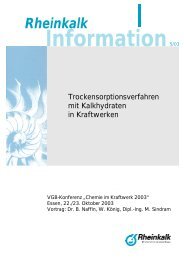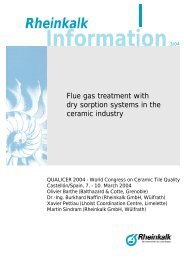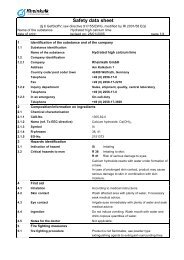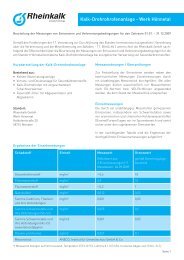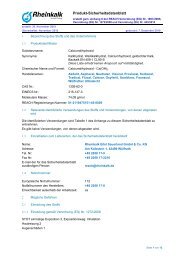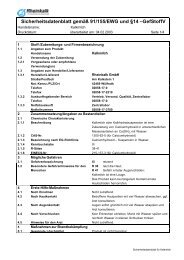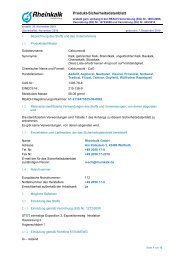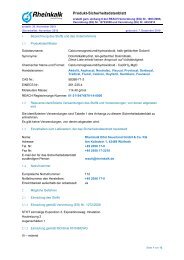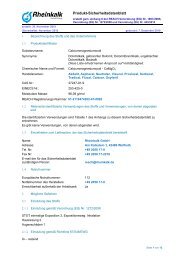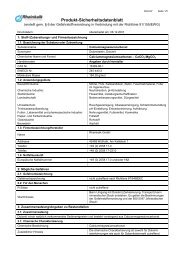SO - Rheinkalk
SO - Rheinkalk
SO - Rheinkalk
Create successful ePaper yourself
Turn your PDF publications into a flip-book with our unique Google optimized e-Paper software.
Eugene Bechoux; Lhoist Western Business Unit, Wavre; Belgium<br />
Dr. Burkhard Naffin; <strong>Rheinkalk</strong>, Wülfrath, Germany (Speaker)<br />
Xavier Pettiau; Lhoist Coordination Centre, Limelette, Belgium<br />
Martin Sindram; <strong>Rheinkalk</strong> GmbH, Wülfrath; Germany<br />
Mark Tomlinson, Lhoist UK, Hindlow, United Kingdom<br />
"Application conditions for highly reactive lime hydrates in dry sorption"<br />
Flue-gas treatment (FGT) processes can be roughly classified into three categories:<br />
1. wet flue-gas cleaning processes,<br />
2. semi-dry flue-gas cleaning processes,<br />
3. dry flue-gas cleaning processes.<br />
Wet FGT processes are primarily used in power stations for flue-gas desulphurisation<br />
(FGD). Because of the process technology the flue gas temperatures of approx. 60 -<br />
70°C in the scrubbing stage is achieved. In the case of semi-dry processes, a lime<br />
milk suspension is introduced into the stream of flue gas so that the flue gas is<br />
cooled by evaporation of the water to a temperature of 140 – 170 °C. The reaction<br />
products are separated as a dry powder by a downstream filter. In the case of dry<br />
processes, the reaction material is introduced as a powder into the flue gas. The high<br />
(850 – 1000 °C), medium (300 – 450 °C) and low (80 – 220 °C) temperature ranges<br />
are used for this (in particular for flue gas treatment of waste incineration plants). Dry<br />
processes have become standard in modern flue-gas cleaning since they offer the<br />
user decisive advantages.<br />
The common factor in all processes is the general use of lime-based products (milled<br />
limestone - CaCO3, lime - CaO, hydrated lime – Ca(OH)2) to neutralise the acid<br />
forming pollutants (HCl, <strong>SO</strong>2, HF). Criteria for the application of these products to<br />
scrub gases are, in addition to chemical purity (CaO content and secondary<br />
components), for<br />
· milled limestone: reactivity and grain-size distribution,<br />
· lime: hydrating behaviour (t60 value, dispersibility),<br />
· hydrated lime: grain-size distribution, specific surface area, pore volume.<br />
From the chemical point of view, hydrated lime is generally used for dry and semi-dry<br />
processes.<br />
The Lhoist Group has been a driving force since the mid-1980s in the development of<br />
products for use in semi-dry and dry processes (WÜLFRAsorp ® , WÜLFRAgran ® ), in<br />
particular. The result of this intensive research was the first hydrated lime with a high<br />
surface area, namely WÜLFRAsorp ® A. While standard hydrated lime usually has a<br />
specific surface area of approx. 18 m 2 /g (according to BET), the specific surface area<br />
of WÜLFRAsorp ® A is approx. 38 m 2 /g. In this way, the surface area available for the<br />
gas-solid reactions in the dry sorption process is, in principle, more than doubled.<br />
Furthermore, the number of particles and dispersibility is markedly increased owing<br />
to the fineness of the product (d50 approx. 3 µm compared to 6 µm for standard<br />
commercial hydrated lime). The intensive development to improve the standard<br />
1




